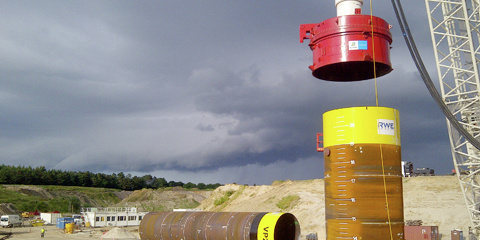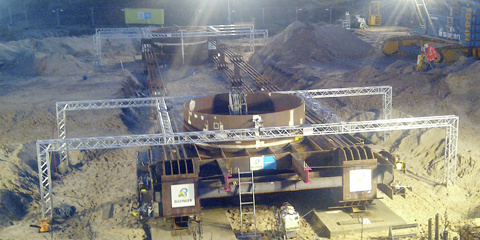News Release from windfair.net
Wind Industry Profile of
Global: Game Changer for offshore industry? Research project presents first results of new installation method
The first test results have now been presented by project leader RWE Innogy and look quite promising: Vibratory piling is not only up to 10 times faster than hammering, but also much quieter – which is an important criterion to the sensitive environment offshore.
Apart from RWE Innogy, the consortium consists of companies such as DONG Energy, Vattenfall, EnBW, E.ON and Bilfinger Offshore. The project was also sponsored by the Carbon Trust Offshore Wind Accelerator, a world-leading research and development programme for reducing the costs of offshore wind energy. Various institutions, research institutes and other companies also contributed: The test piles used were delivered by Steelwind Nordenham while PVE Dieseko supplied the vibrator and IHC Hydrohammer manufactured the hammer. The fact that so many companies have come together for a research project, may well be regarded as a fluke: “The project results not only demonstrate that vibro techniques could be a viable method for piling, but also evidence of what can be achieved through industry collaboration”, according to Jan Matthiessen, Director Innovation at the Carbon Trust. The search for ways to reduce costs in the offshore industry is therefore still in full swing.
Vibrating piles instead of ramming them has already been widely used in the construction industry in cities, so it is known that piles can be installed faster, with low-noise and less tiring. For the offshore project therefore the main question was whether fully vibrated piles are just as stable as rammed piles. In particular, the lateral stability was of interest, because it plays a particularly important role offshore due to constant sea currents.

Hammering (Photo: RWE Innogy)
To test the method, the consortium first had to find a suitable location onshore. Their first idea was to find a test site near the Federal Institute for Materials Research and Testing (BAM) in Berlin, but that was quickly discarded due to the pile size. So the choice fell on a sand pit near Cuxhaven where perfect test conditions could be found: The ground is saturated with water caused by high groundwater and is similar in sand density to the North Sea soil.
Since the piles had to be transported through the Weser Tunnel, there were limitations in size. A scale of 1:3 compared to the North Sea piles was used and handled with Europe's largest onshore crane.
The experiment foresaw the incorporation of three steel pairs, each with one pile hammered and one vibrated into the ground in the first test phase. After the piles were installed, the second test phase started four months later: The piles underwent static load testing, which examined how they behave when subjected to the kind of lateral load that is typical in offshore conditions. Afterwards, the results were evaluated by the Leibnitz University Hannover in the third test stage.
First positive results were shown already while the piles were installed: Hammering a pile took 32 minutes, while the vibrated one went into the ground just after two minutes. Installation time of the vibrated piles was up to ten times shorter than that of the hammered ones. It must be mentioned though that such figures cannot be achieved offshore: The test piles weren't directly attached - and thus controllable - to the crane during the vibration process because the crane would have collapsed due to the vibrating movements. So the industry needs to come up with further ideas to solve this problem before offshore vibratory piling is actually possible.

Static load testing (Photo: RWE Innogy)
The stability of rammed and vibrated piles show similar results – here, however, the consortium came to notion that the results depend largely on the entire installation concept which also means pile design and frequency of the vibrator play their part. After completion of this project at the end of the year, RWE Innogy will therefore carry out further tests in order to investigate this special aspect of the results before the vibratory piling will actually hit the market as an alternate installation method.
Particular attention was paid to noise pollution: The results show that the maximum sound pressure level of the vibration method falls significantly lower than in the conventional ramming technique. However, it must be examined in more detail how the overall longer-lasting, but constantly high sound exposure effects the environment. Overall, the noises during the tests stayed below the level of 160 decibel which is crucial for the German market. Thus, it is conceivable for the future that expensive methods for noise reduction such as the use of a bubble curtain could be eliminated for vibro installation.
After completion of the project there is still a whole range of other issues to be clarified. The Vibro consortium actively supports several R&D projects that simulate the installation of vibratory piling, for example: the numerical installation of vibrating and hammered piles or cone penetration tests in vibration, which are currently carried out by the University of Bremen.
RWE Innogy is now investigating different factors in order to optimize the vibro method through the course of further R&D projects. Benjamin Matlock, Offshore Wind Civil Engineering of RWE Innogy, is optimistic that the method can be used for the first time in 2017 or 2018 in an offshore wind farm: “Throughout the project we have collected a lot of important data, that can now be used to further develop the technology to bring it offshore.”
- Author:
- Katrin Radtke
- Email:
- kr@windmesse.de

